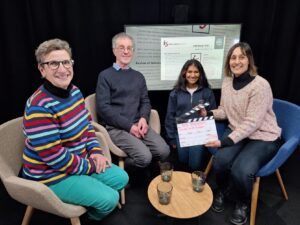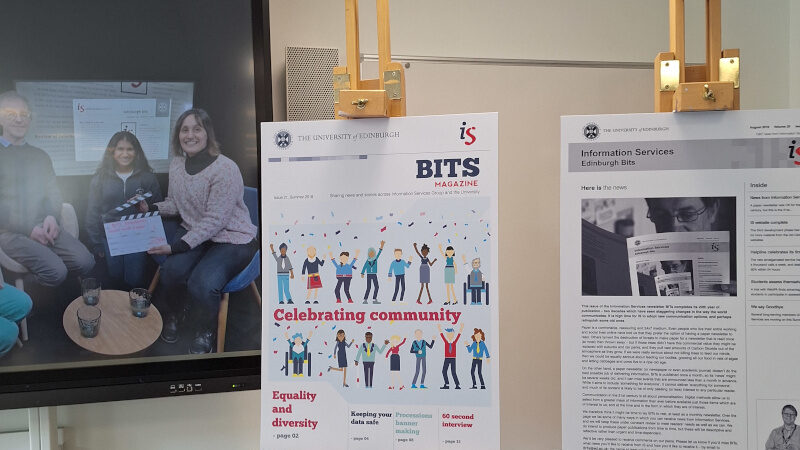Name: Jasmine Patel
Year of study and degree: 2nd year International Relations and International Law
Internship: Digital Preservation
Teams within IS: Digital Archiving Team in Heritage Collections, Graphic Design in Learning Teaching and Web
Favourite meal deal: Southern fried chicken wrap, Cinnamon bun, Innocent smoothie
Favourite podcast right now: The Global Story
Favourite album right now: Educazione Sabauda
I’ve been working over the summer with Sonia Virdi (Graphic Design Manager) and Sara Day Thomson (Digital Archivist) to digitally preserve editions of the BITS Magazine. BITS is an acronym and actually stands for the Bulletin of IT Services.
The final piece of work I completed was to launch an online exhibition of BITs magazine, which was completed in August.
I’ve been blogging throughout my internship and you can read the posts here –
- Welcome to the world of digital preservations
- All Things BITs – A conversation with Sonia Virdi
- Things I’ve learnt from working with the BITS Magazine
I’ve been working on digitally preserving the BITs publication since summer 2023. From January 2024, I began to put together an exhibition to showcase the history, illustrations and graphic design contained within it, and what a journey it’s been.
It all started in around 2005, when the Graphic Design Team got involved in designing BITs. When Information Services formed to bring together various departments under one identity, the remit of BITs expanded, and this is reflected in its design. Over 15 years, BITs was transformed from a basic two colour bulletin to a full colour magazine, with colourful, eye-catching illustrations and covers. The Graphic Design Team had archived original design files of BITs onto CDs and DVDs, many of which are now around 20-30 years old, (older than me!) and it was my job to extract these files off them, not only with the aim of preserving BITs, but to make elements of the graphic design available to potential future users.
In the early 2000s, CDs were believed to be the perfect robust, shiny storage solution, however I very quickly found out otherwise. The first few discs were unreadable, and overall 10 had corrupted, which was especially disappointing as I knew that some of these had BITs files on them. This was perhaps expected, but struggling to get hold of a disc reader was a new low. The first week revealed the true fragility of even the most solid looking media in the face of rapidly evolving technology, and the importance of digital preservation.
Despite the bad start, a mix of creativity and perseverance led me to discover a lost legacy document store through Internet Archive, containing hundreds of PDF copies of BITs and the Learning Technology Supplement, which along with files from the CDs, allowed us to collect together 230 editions of BITs in total. These spanned the different design iterations from 1994 to 2019, forming almost a full series, which was a massive achievement.
My favourite part of the internship was reading BITs. I was fascinated by the history of technology that BITs documented. I got quite over excited about the year 2000 problem, the invention of the World Wide Web, email and the predecessor to the virtual learning platform which we use today at the University Web CT. BITs really is a unique historical document, reflecting changes in the organisation of Information Services through its graphic design and tracing how Information Services has been serving the academic community over the years. It’s been incredibly insightful to read about this, and learn about the work going on today from speaking to colleagues, since as a student the work of people in Information Services still remains quite hidden, something BITs tried to change.
All my newfound knowledge and understanding of BITs and Information Services was put to good use when it came to creating the BITs catalogue, making sure the structure reflected the history, but more so when it came to putting together the BITs online exhibition. Humans do digital preservation for a reason. Being selective about what content to archive, include in the exhibition, how to archive the exhibition itself, little things like deciding between ‘BITs’ or ‘BITS’ (if you’re wondering it was just a style choice), and choosing which stories to spotlight were a crucial part of carrying out this work, but often involved making difficult choices when there was no obvious answer.
I started working on the exhibition in January, and although stressful at times, I’ve loved it, developing a completely new set of skills. Without a doubt, the highlight was meeting Nick Stroud, former editor of BITs and Nora Mogey, Head of the Media and Learning Technology Service. They may have been celebrities to me at this point and I learnt a lot from their imparted wisdom – it was great to have them contribute to the project. Equally, the best part of this work was getting to collaborate with so many different people in different teams, from Graphic Design to the Media Team, Heritage Collections and Website and Communications. BITs brought people together, encouraged colleagues in Information Services to find out about each other’s work, acknowledge each other’s achievements and collaborate. I’m glad we were able to continue this legacy through the exhibition and the wider project to preserve BITs.
Please check out the exhibition online!



